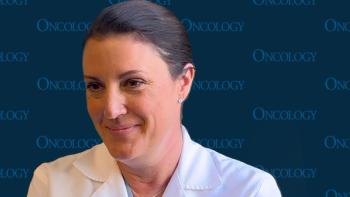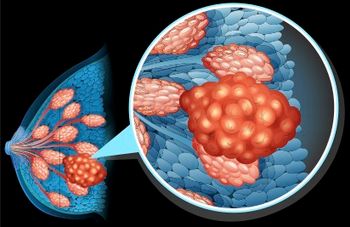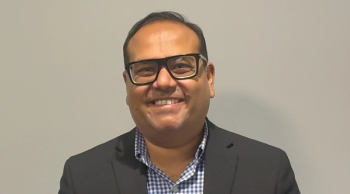
Oncology NEWS International
- Oncology NEWS International Vol 9 No 8
- Volume 9
- Issue 8
Leading Investigators Say Breast Cancer Research Is Paying Off Paying Off
NEW YORK-Dramatic advances in the treatment, detection, and prevention of breast cancer are occurring because of research efforts of the past 30 years, experts emphasized at the International Roundtable on Breast Cancer: Today’s Choices, Tomorrow’s Chances for a Cure, sponsored by the American-Italian Cancer Foundation and the Susan G. Komen Breast Cancer Foundation.
NEW YORKDramatic advances in the treatment, detection, and prevention of breast cancer are occurring because of research efforts of the past 30 years, experts emphasized at the International Roundtable on Breast Cancer: Todays Choices, Tomorrows Chances for a Cure, sponsored by the American-Italian Cancer Foundation and the Susan G. Komen Breast Cancer Foundation.
We can calculate that 350,000 women are alive today because of the use of tamoxifen [Nolvadex], said V. Craig
Jordan, PhD, DSc, Diana Princess of Wales Professor of Cancer Research and director, Lynn Sage Breast Cancer Research Program, Robert H. Lurie Comprehensive Cancer Center, Northwestern University.
Current tamoxifen research and clinical trials, Dr. Jordan reported, are focusing on prevention of breast cancer in high-risk women. These trials have shown, he said, that tamoxifen taken for 5 years reduces breast cancer in high-risk women by about 50%. The women who take tamoxifen have half as many breast cancers as those who do not, he observed.
In the adjuvant setting, Dr. Jordan noted, 5 years is the standard duration for tamoxifen in the United States. When stopped at that point, he added, the patient continues to be protected for at least 5 years by an action that is not understood at this point.
It is almost like an invisible hand that keeps protecting the person, he said, so you dont need to continue the patient on tamoxifen. The 5-year duration of treatment is, however, more effective than 2 or 3 years, he stressed.
Tamoxifen, the first agent shown to prevent breast cancer, is now being tested against raloxifene (Evista) in the STAR (Study of Tamoxifen and Raloxifene) trial for which Dr. Jordan is the scientific chairman. Raloxifene, he noted, was developed to treat and prevent osteoporosis, but encouraging preliminary data suggest it may also prevent breast cancer.
Other chemoprevention research efforts, Dr. Jordan said, include planned clinical trials in Italy with a reduced dosage of tamoxifen.
The International Breast Cancer Intervention Study, headquartered in the United Kingdom, he added, is planning a trial in postmenopausal women of aromatase inhibitors, the next generation of agents that control the metabolism of estrogen.
Research on selective estrogen receptor modulation, he suggested, may eventually produce compounds that fool the brain into thinking theyre estrogen, so you can prevent breast cancer without postmenopausal symptoms.
Breast Screening Innovations
For Susan M. Love, MD, adjunct professor of surgery, UCLA, and founder and CEO of
The road to breast cancer, Dr. Love explained, probably begins in the lining of the lactiferous ducts with the development of atypical cells and hyperplasia. It occurred to me that milk comes out the duct, and maybe we could go in the other direction . . . to sample the lining of the duct, she said. Toward that end, she is exploring the use of catheters to extract cells from ducts.
In her research, she found early work by George Papanicolaou, renowned for developing the Pap smear for cervical screening. He was actually the first one to think of suctioning a little bit of fluid from the breast ducts and looking at it for abnormal cells, she said.
In this 1950s research, she noted, Dr. Papanicolaou did, in fact, find atypical cells. He just didnt know what to do about it, she observed. It wasnt until the 1970s that researchers showed that women with atypical cells had a higher risk of getting breast cancer down the road, she said.
Dr. Love is also interested in defining which ducts are most likely to harbor precancerous cells. Clinical trials have begun, she reported. I think it holds a lot of promise, she said. If it succeeds, we can start to pick out who should get chemoprevention and then follow them to see if it works.
Biologic markers are another potential way to detect patients who are at risk of developing breast cancer, Dr. Love noted. Can we, she asked, find a blood test like PSA for breast cancer? There are some candidates that look promising in very small studies and that need to be studied in much larger groups.
Molecular Biology
Larry Norton, MD, head of the Division of Solid Tumor Oncology and director of the Lauder Breast Center, Memorial Sloan-Kettering Cancer Center, said that thanks to molecular biology, analysis of small tissue samples may reveal an individuals risk for breast cancer and also factors that make their disease unique.
Expression profiling, a growing branch of science, he explained, is directed toward finding out what it is within the cells that makes the tumor click. These findings, he noted, then can be used to devise new weapons against those specific abnormalities.
The cascade of molecular events involved in signaling cells to divide, Dr. Norton said, is beginning to be understood more clearly. One target identified in this research is tubulin, a molecule that divides the DNA into little packets full of chromosomes, and then pulls them apart. Taxanes, such as paclitaxel (Taxol), he said, attack tubulin.
In addition, research is showing that tubulin is a constituent of blood vessels that helps them retain rigidity. A whole new class of drugs, Dr. Norton suggested, can be developed to attack the neo-angiogenesis associated with cancers. That looks to me extremely promising, he said.
This research may also open a new avenue of treatmentmetronomic therapy. Its premise, he explained, is to keep tumors small by not allowing them to grow. Although not eradicated, the tumors would cease to be a threat to their host environments.
The intimate relationship between cancer cells and the immune system, Dr. Norton noted, has prompted research on vaccines. Those tried for breast cancer in the past have not worked well, he indicated, because they aimed at a specific target rather than striking at the tremendous heterogeneity in cancer cells. What you need is a polyvalent approach, he said, that will use a variety of antibodies to attack different cells.
A pilot study with a multivalent vaccine for breast cancer, he reported, will be conducted this year. The next step will be a large multi-institutional study to see if this vaccine can complement adjuvant drug therapy to prevent cancers from growing back, he said.
Adjuvant Therapy
Adjuvant systemic therapy currently saves more lives than any other medical oncologic procedure, asserted Aron Goldhirsch, MD, director, Department of Medicine and Radiotherapy, European Institute of Oncology, Milan.
A recent report, he noted, showed that adjuvant therapy lowered mortality in all age groups, but especially in the young and middle-aged.
Nonetheless, administering such therapy after tumor removal is difficult because you cant see the results with your eyes, Dr. Goldhirsch said. There is no diagnosable sign of tumor, and you must rely on results of trials in the past that this is indeed a suitable treatment.
Dr. Goldhirsch looks forward to the development of niche treatments in which each type of breast cancer will be treated in a specific way based on biologic knowledge. The Breast International Group (BIG), he reported, has been formed to conduct trials to rapidly answer questions about niche treatments.
Even without such targeting, Dr. Goldhirsch said, great progress has been made in improving chemotherapies. As an example, he cited the increased understanding of the interaction between combination chemotherapy and endocrine therapy.
Neoadjuvant therapy to shrink cancers prior to surgery seems a very good idea, Dr. Gold-hirsch said, but must take into account the chemosensitivity of the tumor. A randomized trial, he noted, found that such therapy was very good at reducing the size of the tumor and allowing more women to have breast-conserving surgery, but it didnt change the efficacy of tumor control.
Milestones in Surgery
A pioneer of breast-conserving surgery, Umberto Veronesi, MD, PhD, Italys Minister of Health, headquartered in Milan, observed that surgery for breast cancer today is totally different from 30 years ago.
At that time, he and several other surgeons challenged the need for a total mastectomy for women with small tumors and began performing quadrantectomies or lumpectomies. Every year now, he said, there are some 300,000 women who have their breasts saved.
Another sea change in breast cancer surgery, Dr. Veronesi said, occurred 5 years ago with the introduction of sentinel lymph node biopsies. This procedure, he noted, allows sparing of the lymph nodes in 70% of women, resulting in much less surgeryand less sequelae.
Intraoperative Radiotherapy
Today, Dr. Veronesi, who founded the European Institute of Oncology, is involved in a new radiotherapy approach for women who have quadrantectomies. Instead of postoperative radiotherapy extending for 5 or 6 weeks, the entire dose of radiation is delivered intraoperatively with a specially designed linear accelerator. We give 22 Gy in a single dose, which is equivalent to 55 Gy with fractionated dosing, he said. Because the skin is not irradiated, he said, side effects of radiation are eliminated.
The rationale for the new approach, Dr. Veronesi explained, sprang from a review of 2,000 cases showing that 92% of recurrences were in the same area as the original tumor. As a result, he asserted, irradiation of the entire breast is not needed, and we may concentrate radiation to the quadrant where the tumor was originally.
Dr. Veronesi and his associates began using the intraoperative approach a year ago in a small group of patients. So far, the results are very good, he said. Everything suddenly becomes simple, he observed. We remove the tumor. We remove the sentinel node. We give the radiotherapy. This way, in 1 or 2 hours, all of the treatment is given to the patient. The next day the patient is at home, and she doesnt need anything more.
Articles in this issue
over 25 years ago
Scientists Identify Gene Mutations in Multiple Myelomaover 25 years ago
Single-Agent Herceptin Active in Metastatic Breast Cancerover 25 years ago
Brain Metastases Respond to Paclitaxel, Carboplatin, and Brain RTNewsletter
Stay up to date on recent advances in the multidisciplinary approach to cancer.


















































































